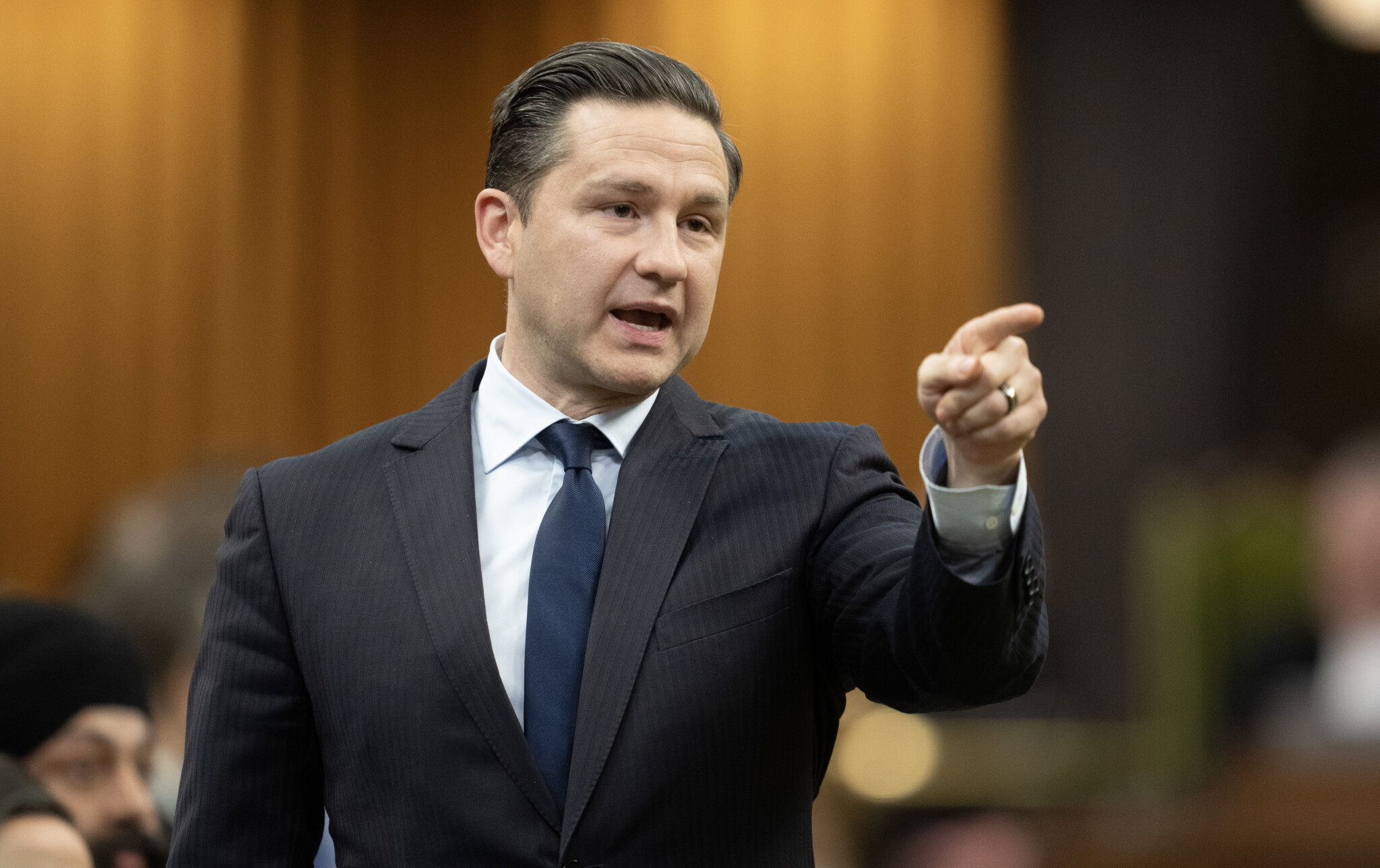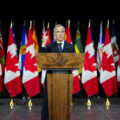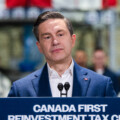The federal election scheduled for next year presents Pierre Poilievre and the Conservative Party with two distinct but interconnected opportunities. The first is a political opportunity to redefine the “centre” in Canadian politics. The second, a policy opportunity to implement transformational and lasting change in Ottawa—the change required to actually fix a “broken” Canada.
The list of Canadian conservatives who have been able to successfully seize such opportunities is short. It does include one name with particular relevance to the present time: former Ontario Premier Mike Harris. Harris created the original “common sense” brand, and it helped him achieve back-to-back landslide majorities and enabled a series of fundamental alterations to the policy status quo in Ontario—alterations which proved both consequential and long-lasting.
In this two-part essay, Alister Campbell (“Message Guy” in the Harris “Common Sense Revolution” campaign of 1995 and editor of The Harris Legacy) outlines key lessons the Poilievre team must learn from the Harris story. You can read part one here.
“A majority is a terrible thing to waste”
– Anonymous
Few prime ministers are presented with the opportunity to be anything more than “transactional” politicians, managing the files that stream across their desk as best they can. Elected only because it was “time for a change,” the change they actually achieve (if any) during their term or terms in office is seen as “incremental” at best. It is very rare to have the luck to arrive at a time when there is a genuine public appetite for “transformational” leadership.
As I discussed in part one of this essay, Canada’s political history has been dominated by a centre-left coalition that has generally and successfully portrayed Conservatives as “extreme.” For too long, the old federal Progressive Conservative Party was overmatched and schooled by Liberals brilliantly employing this stratagem. Even when the Tories were briefly in power (think Diefenbaker or Clark) they were only there to provide brief relief. Each time the Liberals quickly re-emerged with a new version of the same old recipe and returned rapidly to power. There was little or no lasting policy impact from these interim conservative governments. And the Liberals, as the so-called “natural governing party,” diligently resumed implementing their evolving, centre-left agenda for Canada.
But today’s Canada is almost certainly looking for more—and different. A substantial plurality of the Canadian electorate is in the mood for big change. There is a clear appetite for new policies to fix what Pierre Poilievre has correctly described as broken. This means that Poilievre may well be gifted the exceedingly rare opportunity to be a transformational Conservative prime minister.
But, will he be one? The answer will depend on whether or not he understands how to be one. And there are examples to look to which can help him with this.
The recent passing of former prime minister Brian Mulroney has served as a healthy reminder of what “transformational” Conservative leadership looks like. It was encouraging to note so many ex-Reformers among those at his funeral acknowledging, if only in retrospect, the consequential nature of Mulroney’s legacy. And what a legacy it was. A political legacy with two majorities. And a lasting policy legacy filled with notable accomplishments such as the GST and NAFTA.
More recently, the Conservatives held power in Ottawa again, and for almost a decade. But Stephen Harper spent much of his time as PM in a minority government. It took a freak, one-time Laytonian “Orange wave” in Quebec to give the newly united Conservatives a rare majority. And the timing of the global financial crisis meant that any long-term or transformational initiatives Harper might have hoped to achieve with that majority government leverage were trumped by events (as British Prime Minister Harold MacMillan would have called them).
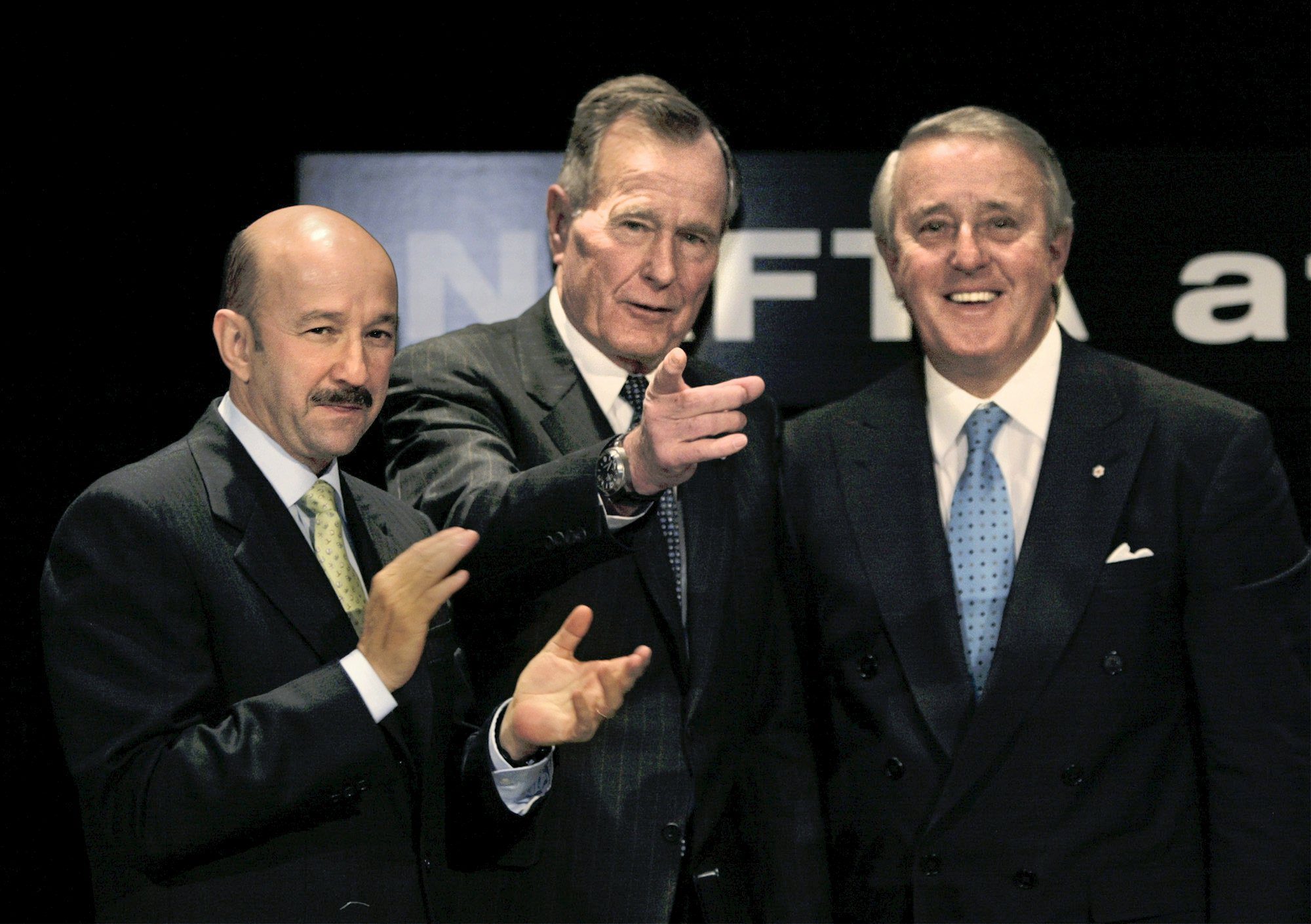
A decade after the U.S., Canada and Mexico signed the North American Free Trade Agreement, former Mexican President Carlos Salinas de Gortari, left, former U.S. President George H.W. Bush, center, and former Canadian Prime Minister Brian Mulroney, right, gather for a conference on NAFTA at the Woodrow Wilson International Center for Scholars in Washington, Monday, Dec. 9, 2002. J. Scott Applewhite/AP Photo.
His list of accomplishments does include some compelling elements worth remembering, however. Cutting the GST to 5 percent (to some extent at least, limiting the financial capacity of gluttonous future Liberal regimes) has proven a lasting reform. The Universal Canada Child Benefit was a visionary, long-term public policy. And future generations will be grateful for his foresight in building the Gordie Howe Bridge and reinforcing the infrastructure binding us to our key neighbour, ally, and trading partner.
But the Harper and Mulroney examples are also a sobering reminder of how few and far between these conservative role models have been. Which is why I believe it is worth looking beyond Ottawa for another example of conservative change leadership to help shape a transformational Poilievre agenda. And one need look no further than Ontario, where the policy accomplishments of Premier Mike Harris, albeit at the provincial level, offer important lessons on how to achieve truly transformational outcomes.
Central to the Harris legacy is the reality that, notwithstanding the controversies of his time, almost none of Harris’s common sense reforms were reversed by his Liberal successors. Why? Because they were the right things to do—and they worked. Many now recognize that Harris should be numbered on the shortlist of truly transformational figures in Canadian political history.
What lessons can Harris teach Poilievre? I see at least a few.
A comprehensive transition plan is key
First, that successful implementation of a transformational change agenda requires careful planning. Harris appointed a transition team at almost the same time as he appointed his campaign team (more than a year in advance of the election). Because the Common Sense Revolution platform was unusually prescriptive about policy intent, the transition team was able to plan out a similarly prescriptive change management and implementation plan.
The Harris transition team understood that real change within a big system requires an effective partnership with a professional, non-partisan civil service. Bob Rae’s NDP Government had appointed a number of partisans to senior roles in the civil service. Harris’ team correctly determined that there was a strong appetite in the civil service for a return to traditional, non-partisan competence. So, they worked to identify the key deputy ministers in the government they could truly work with. It has never been well understood publicly, but central to the success of the “revolution” was the degree to which the Harris change agenda was supported by the senior civil servants the transition team identified.
But, the civil service has to work for the leader. The transition team brought their personnel reviews to Harris early on, so he could start thinking about the type of government and types of relationships he wanted with his cabinet and the senior public service. A small group of former deputies helped look at different cabinet models and configurations of ministries. The transition team carefully thought through the challenges of implementation over the first 100 days, established a vetting process for cabinet ministers, and provided each minister with a policy brief and a binder of resumes for potential staff.
All of this was done quietly, behind the scenes, and without any public fanfare. For Poilievre’s team, this successful transition process represents a crucial lesson in the best practice prerequisites for getting common sense things done.
It is not clear to me if the Harper transition was as well planned. But he did have the benefit of battle-hardened Harris cabinet ministers playing key roles in his cabinet (e.g. Jim Flaherty, John Baird, Tony Clement). While we have sadly lost Flaherty, Baird and Clement are both logical players to help coordinate an upcoming transition planning process. Members of that Harris team are also potential candidates to assist. And other deeply experienced political change leaders like former Alberta Premier Jason Kenney could be recruited and would bring tremendous leadership and insight into the structured change management planning required to ensure effective and lasting change.
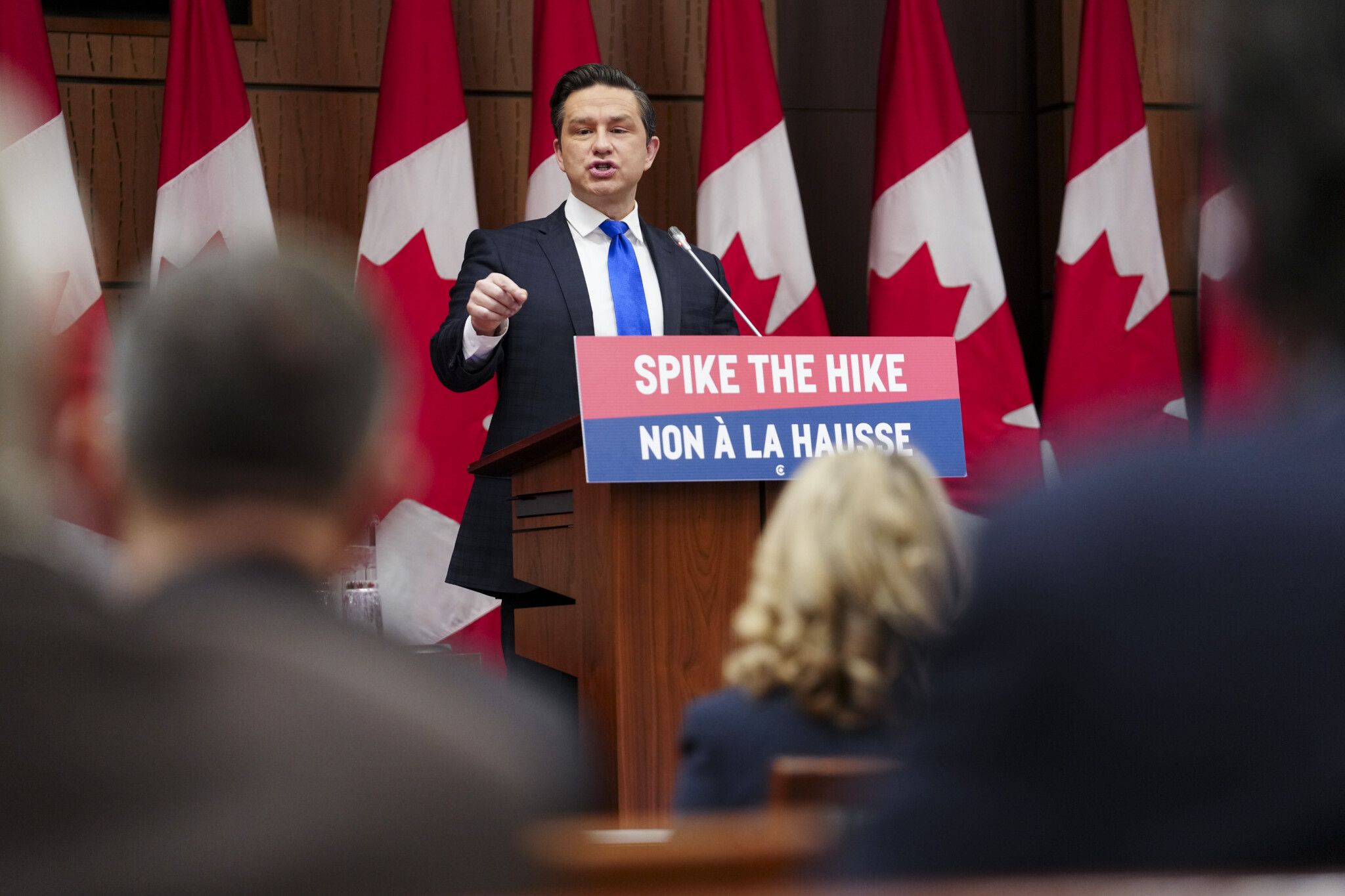
Conservative Leader Pierre Poilievre addresses his caucus on Parliament Hill in Ottawa on Wednesday, March 20, 2024. Sean Kilpatrick/The Canadian Press.
The need for speed
A second lesson is about the importance of speed. On the day he stepped down as premier, Harris was asked if he had any regrets about the implementation of his controversial transformation agenda. Harris replied that he “wished (he) had done more, faster.” Big systems have strong defences. Implementation of big changes to such systems is best done immediately when a new government has a clear mandate for change. And before the defenders of a sclerotic, status quo can regain their balance. All of which also serves to amplify the importance of a clear policy intent and a thoughtful implementation plan being ready long before election day.
Some have publicly urged that Poilievre publish his own Common Sense Revolution agenda before the election. For the record, I am agnostic as to whether or not he does so. I see it has a strategic campaign decision best made by those best informed by the data.
For Harris, mired in third place, 30 points down, with another Opposition party the clear frontrunner, but with a market very open to major change, policy was the strategy. For Poilievre’s Conservatives—clear frontrunners, with an electorate eager for change and firmly of the view that it is time for a change of governing party—circumstances are very different. Whether the policy plan is published as a platform or not, however, the lesson is that you need to have that plan well in advance of victory so that it can start being implemented immediately upon election.
Do the right thing—even if it’s not popular
Finally, the Harris legacy powerfully illustrates the merits of not being afraid to do the right thing. Even if the actions required are unpopular, and even if the benefits are only in the distant future. To cite just one Harris example. As incoming Premier, he inherited an Ontario health care system which had failed to adjust to the realities of modern medicine and the changing requirements of the modern hospital. Predecessors had kept opening new hospitals in the wrong places (mostly rural) and with the wrong, or inadequately funded functionality. He closed 40 of them. And reinvested the savings in the “super-regional” hospital centres and the specialty health-care corridor in downtown Toronto. The Liberal opposition surfed on the ensuing outrage. But when they came to power, they re-opened almost none of those shuttered facilities. Instead, they happily had their photos taken at the ribbon-cutting ceremonies for the modern facilities only Harris’ courageous leadership had made possible. What Harris did was still the right thing to do. He has no regrets.
A federal example also comes to mind. Mulroney implemented the GST and signed the NAFTA trade deal. Chretien was elected promising to “scrap” one and “rip up” the other. He did neither. And subsequently basked in the favourable results of both policies. But Mulroney will be positively remembered by history for his transformational leadership long after Chretien is forgotten. It is always better to do the right thing.
To sum up: Poilievre has two big opportunities ahead of him. A political one. And a policy one. With the right policy framework, a professional transition plan, and a common-sense message that speaks to the centrist majority in this country, he has the rare opportunity to be a transformational figure on the national stage. And, by then firmly and effectively implementing truly common-sense policies once in office, he has the genuinely unique opportunity to fundamentally re-centre Canada’s public policy framework and—for the first time since Sir John A.—re-establish Canada’s Conservatives as the natural governing party of Canada. No pressure.
